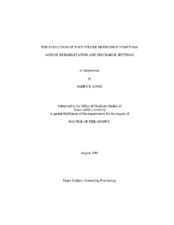| dc.description.abstract | Previous literature has shown that depression is the most common major emotional result following a stroke. Although the prevalence and severity of this issue have been well documented, limited research has been done to identify the evolution of post-stroke depressive symptoms in the acute phase following a stroke. During this period of time, the patient is faced with a number of significant changes from his / her previous level of functioning. These issues can include loss of physical functioning, loss of independence, changes in living arrangements, and an increased reliance on the support and care of others. The purpose of the current study was to examine fluctuations in depressive symptoms as each participant progressed through rehabilitation and discharge, and to gather qualitative information pertaining to the contributing factors that could play a role in this issue.
A sample of nine participants between the ages of 50 and 85 was obtained from a regional rehabilitation unit. Data and clinical information were collected using an intensive case study design. Participants were asked to complete the Geriatric Depression Scale (GDS) at three-day intervals while on the rehabilitation unit and following discharge. This information was interpreted in the context of qualitative information gathered through reports from the participant, his or her significant other / family member, nursing and professional staff members on the rehabilitation unit, and patient records. Other analyses performed included an examination of the interactions between performance and motivation during the rehabilitation process and role of discharge site in the development and course of depressive symptoms.
When examined as a whole, the information collected across all nine participants would suggest that following discharge there was a statistically significant increase in the level of post-stroke depressive symptoms. While the individuals were on the rehabilitation unit, the depressive symptoms decreased significantly and this trend continued following discharge, but the slope was not as significant as that which was observed on the rehabilitation unit. The results also suggested that there is a significant difference between the progression of depressive symptoms between groups separated based on discharge site. | en |


